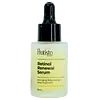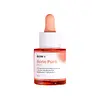What's inside
What's inside
 Key Ingredients
Key Ingredients

 Benefits
Benefits

 Concerns
Concerns

 Ingredients Side-by-side
Ingredients Side-by-side

Water
Skin ConditioningNiacinamide
SmoothingPolysorbate 20
EmulsifyingButylene Glycol
HumectantHydroxypropyl Cyclodextrin
MaskingXylitylglucoside
HumectantAnhydroxylitol
HumectantGlycerin
HumectantEthoxydiglycol
HumectantPhenoxyethanol
PreservativeRetinol
Skin ConditioningAllantoin
Skin ConditioningAcrylates/C10-30 Alkyl Acrylate Crosspolymer
Emulsion StabilisingXylitol
HumectantCaprylic/Capric Triglyceride
MaskingDimethicone
EmollientAloe Barbadensis Leaf Juice Powder
Skin ConditioningCetearyl Dimethicone Crosspolymer
Glucose
HumectantTriethanolamine
BufferingDisodium EDTA
Water, Niacinamide, Polysorbate 20, Butylene Glycol, Hydroxypropyl Cyclodextrin, Xylitylglucoside, Anhydroxylitol, Glycerin, Ethoxydiglycol, Phenoxyethanol, Retinol, Allantoin, Acrylates/C10-30 Alkyl Acrylate Crosspolymer, Xylitol, Caprylic/Capric Triglyceride, Dimethicone, Aloe Barbadensis Leaf Juice Powder, Cetearyl Dimethicone Crosspolymer, Glucose, Triethanolamine, Disodium EDTA
Water
Skin ConditioningCentella Asiatica Leaf Extract
Skin ConditioningNiacinamide
SmoothingCyclopentasiloxane
EmollientDiglycerin
HumectantButylene Glycol
HumectantDimethicone
EmollientPolyglycerin-6
HumectantPEG-8
HumectantAllantoin
Skin ConditioningTocopheryl Acetate
AntioxidantPhenoxyethanol
PreservativeAmmonium Polyacryloyldimethyl Taurate
Emulsion StabilisingHydrolyzed Corn Starch
HumectantPolyacrylamide
Beta Vulgaris Root Extract
Skin ConditioningBakuchiol
AntimicrobialSalicylic Acid
MaskingAminomethyl Propanol
BufferingC13-14 Isoparaffin
EmollientDipotassium Glycyrrhizate
HumectantMethylpropanediol
SolventChlorphenesin
AntimicrobialPropanediol
SolventLauric Acid
CleansingDisodium EDTA
1,2-Hexanediol
Skin ConditioningLactic Acid
BufferingLaureth-7
EmulsifyingLauryl Alcohol Diphosphonic Acid
Emulsion StabilisingIsostearamidopropyl Ethyldimonium Ethosulfate
Sodium Hydroxide
BufferingHylocereus Undatus Fruit Extract
Skin ConditioningScutellaria Baicalensis Root Extract
AstringentBeta Vulgaris Extract
Skin ProtectingCamellia Sinensis Leaf Extract
AntimicrobialGlycyrrhiza Glabra Root Extract
BleachingRosmarinus Officinalis Leaf Extract
AntimicrobialEthylhexylglycerin
Skin ConditioningSodium Benzoate
MaskingCyclotetrasiloxane
EmollientBoswellia Serrata Extract
Skin ConditioningHoney Extract
HumectantOryza Sativa Extract
AbsorbentGlycerin
HumectantPropylene Glycol
HumectantP-Anisic Acid
MaskingOligopeptide-10
Antimicrobial2-Aminobutanol
BufferingCarthamus Tinctorius Seed Oil
MaskingOlea Europaea Fruit Oil
MaskingBromelain
Skin ConditioningPapain
Skin ConditioningWater, Centella Asiatica Leaf Extract, Niacinamide, Cyclopentasiloxane, Diglycerin, Butylene Glycol, Dimethicone, Polyglycerin-6, PEG-8, Allantoin, Tocopheryl Acetate, Phenoxyethanol, Ammonium Polyacryloyldimethyl Taurate, Hydrolyzed Corn Starch, Polyacrylamide, Beta Vulgaris Root Extract, Bakuchiol, Salicylic Acid, Aminomethyl Propanol, C13-14 Isoparaffin, Dipotassium Glycyrrhizate, Methylpropanediol, Chlorphenesin, Propanediol, Lauric Acid, Disodium EDTA, 1,2-Hexanediol, Lactic Acid, Laureth-7, Lauryl Alcohol Diphosphonic Acid, Isostearamidopropyl Ethyldimonium Ethosulfate, Sodium Hydroxide, Hylocereus Undatus Fruit Extract, Scutellaria Baicalensis Root Extract, Beta Vulgaris Extract, Camellia Sinensis Leaf Extract, Glycyrrhiza Glabra Root Extract, Rosmarinus Officinalis Leaf Extract, Ethylhexylglycerin, Sodium Benzoate, Cyclotetrasiloxane, Boswellia Serrata Extract, Honey Extract, Oryza Sativa Extract, Glycerin, Propylene Glycol, P-Anisic Acid, Oligopeptide-10, 2-Aminobutanol, Carthamus Tinctorius Seed Oil, Olea Europaea Fruit Oil, Bromelain, Papain
Ingredients Explained
These ingredients are found in both products.
Ingredients higher up in an ingredient list are typically present in a larger amount.
Allantoin is a soothing ingredient known for its protective and moisturizingg properties. Because of this, it is often added to products with strong active ingredients.
Studies show higher concentrations of this ingredient can promote wound healing.
Though it can be derived from the comfrey plant, allantoin is produced synthetically for cosmetic products to ensure purity.
Learn more about AllantoinButylene Glycol (or BG) is used within cosmetic products for a few different reasons:
Overall, Butylene Glycol is a safe and well-rounded ingredient that works well with other ingredients.
Though this ingredient works well with most skin types, some people with sensitive skin may experience a reaction such as allergic rashes, closed comedones, or itchiness.
Learn more about Butylene GlycolDimethicone is a type of synthetic silicone created from natural materials such as quartz.
What it does:
Dimethicone comes in different viscosities:
Depending on the viscosity, dimethicone has different properties.
Ingredients lists don't always show which type is used, so we recommend reaching out to the brand if you have questions about the viscosity.
This ingredient is unlikely to cause irritation because it does not get absorbed into skin. However, people with silicone allergies should be careful about using this ingredient.
Note: Dimethicone may contribute to pilling. This is because it is not oil or water soluble, so pilling may occur when layered with products. When mixed with heavy oils in a formula, the outcome is also quite greasy.
Learn more about DimethiconeDisodium EDTA plays a role in making products more stable by aiding other preservatives.
It is a chelating agent, meaning it neutralizes metal ions that may be found in a product.
Disodium EDTA is a salt of edetic acid and is found to be safe in cosmetic ingredients.
Learn more about Disodium EDTAGlycerin is already naturally found in your skin. It helps moisturize and protect your skin.
A study from 2016 found glycerin to be more effective as a humectant than AHAs and hyaluronic acid.
As a humectant, it helps the skin stay hydrated by pulling moisture to your skin. The low molecular weight of glycerin allows it to pull moisture into the deeper layers of your skin.
Hydrated skin improves your skin barrier; Your skin barrier helps protect against irritants and bacteria.
Glycerin has also been found to have antimicrobial and antiviral properties. Due to these properties, glycerin is often used in wound and burn treatments.
In cosmetics, glycerin is usually derived from plants such as soybean or palm. However, it can also be sourced from animals, such as tallow or animal fat.
This ingredient is organic, colorless, odorless, and non-toxic.
Glycerin is the name for this ingredient in American English. British English uses Glycerol/Glycerine.
Learn more about GlycerinNiacinamide is a multitasking form of vitamin B3 that strengthens the skin barrier, reduces pores and dark spots, regulates oil, and improves signs of aging.
And the best part? It's gentle and well-tolerated by most skin types, including sensitive and reactive skin.
You might have heard of "niacin flush", or the reddening of skin that causes itchiness. Niacinamide has not been found to cause this.
In very rare cases, some individuals may not be able to tolerate niacinamide at all or experience an allergic reaction to it.
If you are experiencing flaking, irritation, and dryness with this ingredient, be sure to double check all your products as this ingredient can be found in all categories of skincare.
When incorporating niacinamide into your routine, look out for concentration amounts. Typically, 5% niacinamide provides benefits such as fading dark spots. However, if you have sensitive skin, it is better to begin with a smaller concentration.
When you apply niacinamide to your skin, your body converts it into nicotinamide adenine dinucleotide (NAD). NAD is an essential coenzyme that is already found in your cells as "fuel" and powers countless biological processes.
In your skin, NAD helps repair cell damage, produce new healthy cells, support collagen production, strengthen the skin barrier, and fight environmental stressors (like UV and pollution).
Our natural NAD levels start to decline with age, leading to slower skin repair, visible aging, and a weaker skin barrier. By providing your skin niacinamide, you're recharging your skin's NAD levels. This leads to stronger, healthier, and younger looking skin.
Another name for vitamin B3 is nicotinamide. This vitamin is water-soluble and our bodies don't store it. We obtain Vitamin B3 from either food or skincare. Meat, fish, wheat, yeast, and leafy greens contain vitamin B3.
The type of niacinamide used in skincare is synthetically created.
Learn more about NiacinamidePhenoxyethanol is a preservative that has germicide, antimicrobial, and aromatic properties. Studies show that phenoxyethanol can prevent microbial growth. By itself, it has a scent that is similar to that of a rose.
It's often used in formulations along with Caprylyl Glycol to preserve the shelf life of products.
Water. It's the most common cosmetic ingredient of all. You'll usually see it at the top of ingredient lists, meaning that it makes up the largest part of the product.
So why is it so popular? Water most often acts as a solvent - this means that it helps dissolve other ingredients into the formulation.
You'll also recognize water as that liquid we all need to stay alive. If you see this, drink a glass of water. Stay hydrated!
Learn more about Water